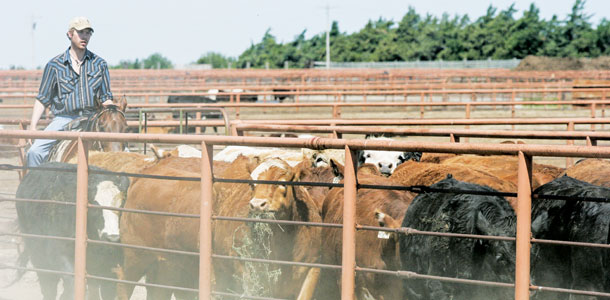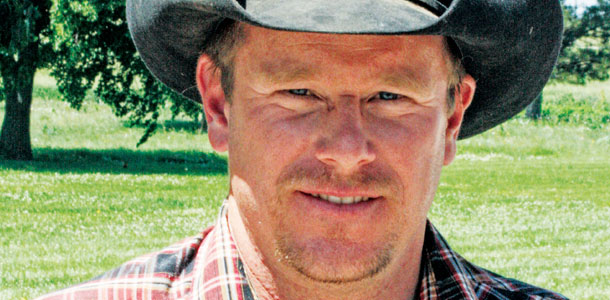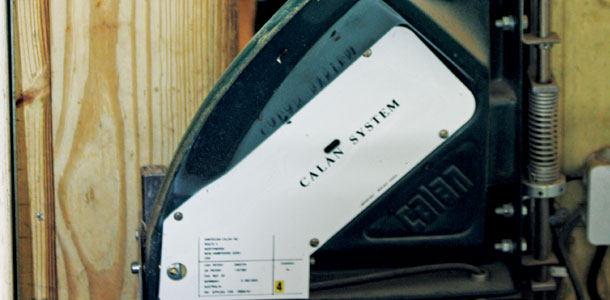If you’re in the beef business, odds are your cattle profits had something to do with a remote government operation in the eastern Nebraska plains.
The U.S. Meat Animal Research Center (MARC), located in Clay Center – some 60 miles from Lincoln – plays a unique role as the scientific beehive for today’s beef industry.
Interested in genomics, DNA markers and breed traits? This is where those innovations were first mapped.
Ever wondered how beef earns its safe marks against E. coli and other pathogen outbreaks? MARC scientists made it possible through a litany of pre-harvest and post-harvest interventions and detection methods.
And if you’re curious how the U.S. has used growth efficiencies to produce more beef with fewer head of cattle, those advances were studied and refined through extensive work at the MARC, as well.
This spring will mark the center’s 50th year in meat animal research for beef, swine and lamb production.

And while the scientific community and nationwide network of extension specialists have long depended on the U.S. MARC as a research mecca for the industry, many producers don’t recognize its importance in boosting beef production.
“Just sitting back and thinking about the institutions involved in beef cattle genetics research, I cannot think of a prominent research group that would not have some collaboration with MARC,” says Dr. Matt Spangler, a University of Nebraska beef genetics extension specialist, who does projects with the facility routinely.
“That speaks to the wealth of data they have and simply the science and expertise there.”
The MARC started as an ag research facility in 1964 after Congress authorized it to change its previous use – as an ammunition depot for the Navy during World War II.
Today, the facility still has remnants of its Defense Department past, with heavy concrete munitions barracks strewn across the pastures of alfalfa.
Those barracks are now empty. The real goods are now grazing the 35,000 acres that cover the MARC.
“If you look nationally and even internationally, from the beef perspective, this is one of the world’s largest resource populations anywhere,” says Dr. John Pollak, director of the facility.
Operated under the USDA Agricultural Research Service, the center has been consistently supported by Congress as a key asset for meat science research that helps drive agricultural production.
“With the advantage of a large cow population and sustainable funding, we’re able to do projects that focus on a cow’s lifetime performance.”
Spangler says the wealth of data and resource population at the MARC is unrivaled to anything around the world. But just as critical is what he calls the facility’s “human capital.”
“You have a group of exceptionally talented scientists at their core, and their mission is to do industry science for the short and long term,” Spangler says.
“That is their passion. Working with them on research and graduate student training is really exciting.”
Research units at the center focus on five key areas – environmental management, genetics-breeding-animal health, meat safety and quality, nutrition and reproduction.
The list of scientific disciplines at the MARC is extensive enough to create projects that relate to all day-to-day operations of the cattle industry. Additional collaboration from universities and industry partners widens the spectrum of research creativity.

Raising animals for research
For studies to become a reality, however, you have to create the cattle.
With around 6,750 female cows on the facility, the MARC easily ranks as one of the largest cow-calf operations in the country – even if it is owned and operated by the federal government.
Along with its slate of nutritionists, microbiologists, physiologists, geneticists, ag engineers and lab specialists, the MARC employs a significant crew of herdsmen and ranchers, all making sure the sizable herd of dams, along with another 250 bulls and 5,000-plus cattle on feed, are all doing their jobs.
Chad Engle, the livestock operations manager at MARC, says labor grow more intense with the arrival of calving season.
In spring, some 4,000 calves are born in about a 75-day calving window, according to Engle – thanks to A.I. strategies.
In the fall calving, which actually comes in late summer, there are another 1,200 calves born at the 10 calving stations dotted around the facility.
“We wean everything in here,” says Engle of all the calves in the feedlot. “We do breeding, heifer development, bull development, in fact we do quite a lot.
“We also found that producing the amount of hay and feed we give them makes them better.”
To that end, the MARC will produce at least 15,000 large round bales of hay annually, feed around 18 to 20 million pounds of corn silage and 190,000 bushels of corn, and 8,000 tons of distillers grain.
The crew at MARC treat their respective domain as their own little ranch, fixing fences, checking pens on horses and following protocols for breeding – all with an emphasis on utilizing Beef Quality Assurance training in every step.
The overarching goal is to follow what the science preaches: Do it efficiently, and do it right.

Templates for research
MARC cattle are phenotyped “for all aspects of meat production,” Pollak says. And the genetics with the high number of cattle helps studies be more thorough and more accurate.
Engle works out a calendar on the five-year plan to align studies with experts and cattle. Because the planning must be done years ahead, many scientists work on the same calf crop for multiple studies – yet it all aligns fairly well.
“So if the feedlot nutritionist says, ‘I want to study beta agonists,’ the microbiologist says, ‘That’s cool because I want to see what happens to the E. coli when they feed it,’” Engle explains.
“The meat taster says, ‘We want to do carcass testing on it, for tenderness.’ It just rolls like that. That’s how we get these huge projects going.”
While some university research may be limited to using 20 or so head of cattle, at MARC the target is to start with 300 head.
A few may drop out, but the higher quantity of animals makes the data more thorough.
The center carefully scrutinizes all proposals to make sure research is transmittable to the industry and producers’ working needs. As a publicly funded enterprise, that information must also be shared, Pollak explains.
“The government arm has obligations for putting information into the public domain. They have obligations for transferring the technology created. And usually, the transfer of technology is better through partnerships with industries and cooperative research agreements.”
One example Pollak notes is the use of genomic-enhanced expected progeny differences (GE-EPDs), now used by Angus and a growing number of breeds with high-density marker panels.
When today’s producers learn of the 50K Illumina assay for genotyping single-nucleotide polymorphisms (SNPs), it’s a technology hatched with the help of the MARC.
“That panel worldwide has become the standard for a genomic baseline for what everybody uses,” Pollak says, the additional role played by the universities of Missouri and Alberta, and USDA-ARS Beltsville in creating the tools for “basic research in DNA structure, and understanding mutations that led to that panel. That’s pretty cutting edge.”
Today, the center is addressing bovine respiratory disease (BRD) risk factors and aspects of treatment and vaccination, sequencing the genomics for BRD complex pathogens as well as outbreak strains and innocuous strains, and determining antibiotic resistance – all of it representing cutting-edge research.
Spangler says the end results of these studies give the industry empirical data to improve modern practices and elevate the scientific benefits found in meat production agriculture.
“We’re all guilty of complaining about the government from time to time, but here’s a shining example of where government resources are going to work to benefit an industry.”

Efficiency, and more with less
Pollak says if there’s any central focus binding all the projects together at the MARC, it’s “the entire cowherd efficiency as measured by amount of edible product per animal exposed per unit of animal with feed.”
“The only way you get there is through efficiency, and that’s the largest portion of our research,” Engle adds. “You can do more with less in ag, especially beef cows because that’s the one that takes the most days to produce.”
In summer, the MARC feedlot showcases two separate pens, one structured with poles planted along the outer fences.
On top of them are snow fences some 30 feet above the ground – serving as shades for the cattle below. The shades are aligned for cool shadows to move across the pen through the day – so the cattle don’t remain in one spot.
The shade study uses temperature probes to document stress on some 650 head of cattle in the pens. Across the road is another pen, these without shade, to provide contrasting data on how cattle feed and grow with and without more shade.
“I don’t think you’re going to find anything like it in other feedlots,” Engle says. “When you talk to feedlot operators about shade, they think it’s a great idea, but it’s expensive and cumbersome to clean around. This is a very inexpensive thing you can do with light poles and snow fence.”
A few miles across the center is another feeding facility, recently renovated with new fencing, gates, extended flooring and hydraulic feedbunks.
The gates unlock an individual feedbunk specifically programmed for an individual steer.
The facility is for numerous projects related to feed intake. The cattle in the facility in early summer were cattle created under the collaborative project Engle and Pollak call the Weight Trait Project.
Calves were created using bull semen from collaborating seedstock producers representing seven different breeds.
The cows bred to the bulls represent uniform genetics for the study. Through this pattern, the bulls within and across the breeds are being compared when mated to similar types of cows.
The research is tied to a five-year USDA feed efficiency grant awarded to nearby universities and the MARC.
“As the research side creates genomic predictions for feed efficiency, we’ll come back to this feed demonstration and study what would have predicted the performance,” Pollak says.
“The genomics provide to these producers a valid predictor of feed conversion. That alleviates the need for them to do progeny testing for feed efficiency.”
The next 50 years
Spangler sees the facility being a key player in helping solve those “big-picture things” that face the meat industries.
The biggest challenge will remain the global mandate for more efficiency, especially as it ties together the sciences of genetics and nutrition research.
In regard to genetics, Spangler says the MARC is at the forefront of uncovering the genetic basis for susceptibility to disease. Those studies keep the genetic emphasis critical to most extension bases around the country.
“Their work is driven by current and future industry needs, and the results arising from this insightful research fuel our extension programs,” he says. “It’s truly a symbiotic relationship between them and us here.” ![]()
PHOTOS
TOP: Cattle in a pasture
PHOTO 2: A pen rider at the U.S. MARC feedlot takes some crossbred steers through the alleys.
PHOTO 3: Chad Engle, livestock operations manager at the U.S. Meat Animal Research Center.
PHOTO 4: The weight-trait study at the U.S. MARC utilizes cattle trained on Calan gates at the bunk.
PHOTO 5: The feedlot shade study utilizes winter fence as shade to gather data on heat and gain. Photos by David Cooper







